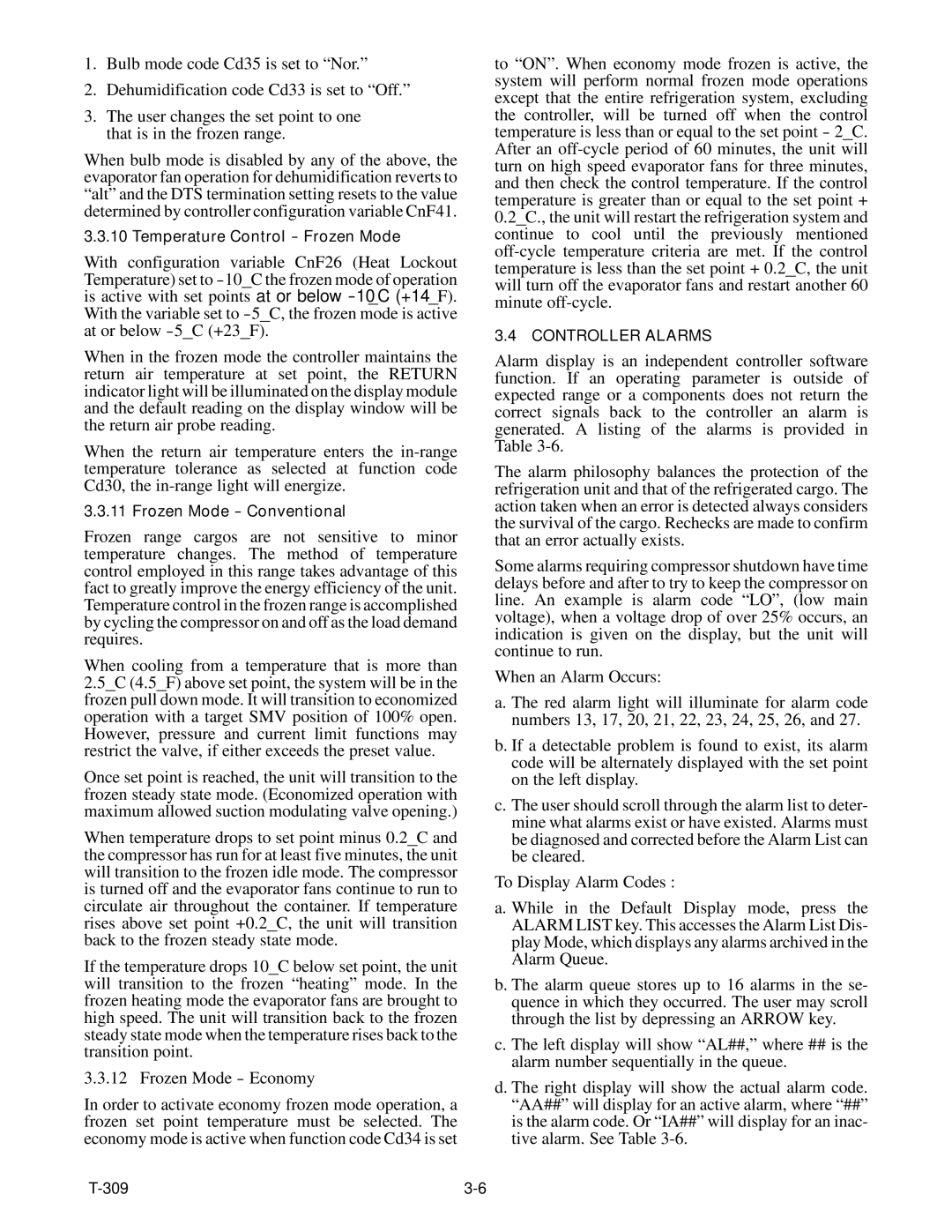1.Bulb mode code Cd35 is set to “Nor.”
2.Dehumidification code Cd33 is set to “Off.”
3.The user changes the set point to one that is in the frozen range.
When bulb mode is disabled by any of the above, the evaporator fan operation for dehumidification reverts to “alt” and the DTS termination setting resets to the value determined by controller configuration variable CnF41.
3.3.10 Temperature Control -- Frozen Mode
With configuration variable CnF26 (Heat Lockout Temperature) set to -10_C the frozen mode of operation is active with set points at or below -10_C (+14_F). With the variable set to -5_C, the frozen mode is active at or below -5_C (+23_F).
When in the frozen mode the controller maintains the return air temperature at set point, the RETURN indicator light will be illuminated on the display module and the default reading on the display window will be the return air probe reading.
When the return air temperature enters the in-range temperature tolerance as selected at function code Cd30, the in-range light will energize.
3.3.11 Frozen Mode -- Conventional
Frozen range cargos are not sensitive to minor temperature changes. The method of temperature control employed in this range takes advantage of this fact to greatly improve the energy efficiency of the unit. Temperature control in the frozen range is accomplished by cycling the compressor on and off as the load demand requires.
When cooling from a temperature that is more than 2.5_C (4.5_F) above set point, the system will be in the frozen pull down mode. It will transition to economized operation with a target SMV position of 100% open. However, pressure and current limit functions may restrict the valve, if either exceeds the preset value.
Once set point is reached, the unit will transition to the frozen steady state mode. (Economized operation with maximum allowed suction modulating valve opening.)
When temperature drops to set point minus 0.2_C and the compressor has run for at least five minutes, the unit will transition to the frozen idle mode. The compressor is turned off and the evaporator fans continue to run to circulate air throughout the container. If temperature rises above set point +0.2_C, the unit will transition back to the frozen steady state mode.
If the temperature drops 10_C below set point, the unit will transition to the frozen “heating” mode. In the frozen heating mode the evaporator fans are brought to high speed. The unit will transition back to the frozen steady state mode when the temperature rises back to the transition point.
3.3.12 Frozen Mode - Economy
In order to activate economy frozen mode operation, a frozen set point temperature must be selected. The economy mode is active when function code Cd34 is set
to “ON”. When economy mode frozen is active, the system will perform normal frozen mode operations except that the entire refrigeration system, excluding the controller, will be turned off when the control temperature is less than or equal to the set point - 2_C. After an off-cycle period of 60 minutes, the unit will turn on high speed evaporator fans for three minutes, and then check the control temperature. If the control temperature is greater than or equal to the set point + 0.2_C., the unit will restart the refrigeration system and continue to cool until the previously mentioned off-cycle temperature criteria are met. If the control temperature is less than the set point + 0.2_C, the unit will turn off the evaporator fans and restart another 60 minute off-cycle.
3.4 CONTROLLER ALARMS
Alarm display is an independent controller software function. If an operating parameter is outside of expected range or a components does not return the correct signals back to the controller an alarm is generated. A listing of the alarms is provided in Table 3-6.
The alarm philosophy balances the protection of the refrigeration unit and that of the refrigerated cargo. The action taken when an error is detected always considers the survival of the cargo. Rechecks are made to confirm that an error actually exists.
Some alarms requiring compressor shutdown have time delays before and after to try to keep the compressor on line. An example is alarm code “LO”, (low main voltage), when a voltage drop of over 25% occurs, an indication is given on the display, but the unit will continue to run.
When an Alarm Occurs:
a. The red alarm light will illuminate for alarm code numbers 13, 17, 20, 21, 22, 23, 24, 25, 26, and 27.
b. If a detectable problem is found to exist, its alarm code will be alternately displayed with the set point on the left display.
c.The user should scroll through the alarm list to deter- mine what alarms exist or have existed. Alarms must be diagnosed and corrected before the Alarm List can be cleared.
To Display Alarm Codes :
a. While in the Default Display mode, press the ALARM LIST key. This accesses the Alarm List Dis- play Mode, which displays any alarms archived in the Alarm Queue.
b. The alarm queue stores up to 16 alarms in the se- quence in which they occurred. The user may scroll through the list by depressing an ARROW key.
c. The left display will show “AL##,” where ## is the alarm number sequentially in the queue.
d. The right display will show the actual alarm code. “AA##” will display for an active alarm, where “##” is the alarm code. Or “IA##” will display for an inac- tive alarm. See Table 3-6.
